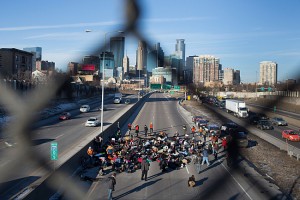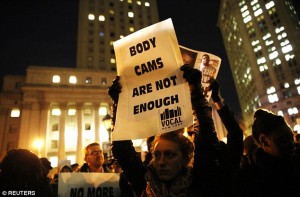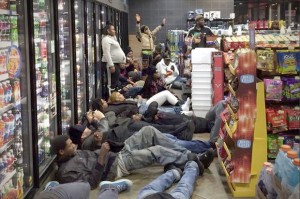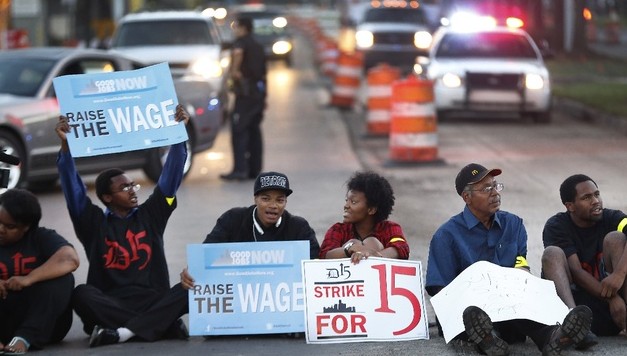For the tens of thousands demanding justice for Mike Brown and Eric Garner, the connection between economic injustice and state violence couldn’t be clearer. Just a few miles from where police murdered Eric Garner, a low-income black man selling loosey cigarettes to scrape out a living, the white collar criminals on Wall Street remain free to continue their corrupt, illegal financial schemes.
The new movement against police racism, born in Ferguson following the police murder of Mike Brown, has flowered into the most significant popular revolt since Occupy Wall Street. Tens of thousands are searching for a way to take the momentum forward. A potential strategy emerged when the week of action for “$15 and a Union” coincided with the national surge of protests against the lack of indictments for the police who killed Mike Brown and Eric Garner.
Protests and Strikes in 200 Cities
It was only two years ago, in December 2012, when the slogan “$15 and a union” debuted with the first fast food strike in New York City, organized by the Service Employees International Union (SEIU). The slogan was greeted with enthusiasm by workers and young people radicalized by Occupy Wall Street’s critique of inequality and corporate corruption.
Politicians and mainstream media ridiculed the idea of raising up minimum wage workers to $15 an hour as completely unrealistic. Even SEIU at first limited the slogan to fast food, rather than bringing $15 an hour firmly into the national debate on the minimum wage.
How much has changed. With the victories for $15 an hour in Seattle and then San Francisco, combined with escalating strikes and actions by low-wage workers, $15 has gone mainstream. Much like the 8-hour day galvanized labor in a previous era of robber barons, so too has $15/hour emerged as a rallying cry for today’s vast, multi-racial army of low-wage workers.
Mostly organized by SEIU, alongside OUR Walmart and numerous local coalition partners, workers came onto the streets in nearly 200 cities during the national week of action between Black Friday and and December 4th. At Wal-Marts, McDonalds, airports, and government buildings, these were the biggest actions yet for “$15 and a union.”
Most of the strikes drew only small numbers of workers to join rallies with community supporters. Yet the potential for this developing into a mass campaign was never clearer, especially where youthful #BlackLivesMatter protests merged together with low-wage worker strikes.
Connecting to #BlackLivesMatter
Across the country, the youthful protests against police racism openly expressed their solidarity with the fight for $15. The widespread mood to #ShutItDown, most reflected in highway takeovers, found even sharper expression in marches through Wal-Marts and shopping malls, where chants and speeches often made the connections between economic inequality and police racism.

There is widespread understanding that racism is structurally embedded into the economy and political life of American capitalism. For a movement against racist police violence to be sustainable, demands for community control over police must be combined with economic demands that address mass unemployment, low-wages, and underfunded services in communities of color. Demands for living wage jobs and quality public services can also unite wider numbers of workers in the struggle for racial equity. Alongside demands for full employment, affordable housing, and quality services, the fight for $15 offers a clear path forward, especially given the concentration of people of color into low-wage jobs.
In this context, SEIU and other union leaders are missing a major opportunity to extend the fight for $15 into a mass struggle with deep roots in communities of color. In a few cities, more far-thinking SEIU locals and Our Wal-Mart made efforts to openly link up the fight for $15 with the Ferguson-inspired protests, but unfortunately this was the exception.
The potential exists to further transform the national conversation, educating millions of workers that solidarity against racism is crucial if we are to build a broad, multi-racial mass movement capable of overcoming corporate domination of our economy. If union leaders fail to mobilize their resources to offer active solidarity with #BlackLivesMatter protests, and extend a serious invitation to fight together for $15, this window of opportunity could pass.
The Democratic Party’s Role
Unfortunately, the union leaders’ ties to the Democratic Party at the national and local level – where Democratic mayors oversee racist police policies in most major cities – undermine their ability to win the trust of youthful protesters. These same Democratic Party leaders have played a generally conservative role in the fight for $15. They sometimes offer solidarity in words to fast food workers protesting McDonalds, but fail to champion $15 where they have the power to act at the city, state, and federal level.
During the Ferguson protests especially, the Governor and other Democratic Party politicians who intervened did so mainly to quell the protests, either through supporting police repression or demanding protesters clear the streets to restore “peace.”
So it is understandable that many youthful #BlackLivesMatter protesters are afraid that partnering with politicians and union leaders risks co-optation. Some will remember that during the Occupy movement in 2011, SEIU’s president Mary Kay Henry orchestrated a joint national day of action with Occupy Wall Street leaders, only to use the event to offer SEIU’s high profile early endorsement of Obama, calling him the “President of the 99%” to the outrage of most Occupy activists.
There is mass popular anger at income inequality, racism, sexism, environmental destruction, and the corporate corruption of both major political parties. Polls show half of all young people have a negative view of capitalism, and anti-capitalist consciousness is highest in Black communities. The same youthful, combative, and radical mood expressed in the Occupy Wall Street protests of 2011 are present today in the #BlackLivesMatter movement, with the crucial difference that today’s movement is bringing a more oppressed, working class section of youth to the forefront.
However, like Occupy before, the new movement against police racism will quickly face tough decisions. Endless protests and highway takeovers, if not connected to a clearly understood strategy to win tangible victories, will eventually exhaust the movement. A section of activists will be co-opted into the well funded non-profits and Democratic Party aligned efforts pushing for small-scale reforms.
Limiting our demands to band-aid reforms like police cameras or slowing the flow of military weaponry to local police, while positive, won’t be enough to inspire the kind of mass movement needed. There is a burning desire to see fundamental changes. Yet many liberal leaders make the mistake of limiting demands to what they believe the current system, the current government, can “realistically” deliver.
This so-called “realistic” approach fails in two ways. It fails because, as Malcolm X famously explained, “you can’t have capitalism without racism,” which means there is no way to meet the expectations of the movement for fundamental change without challenging the whole rotten system.

The liberal approach of limiting our demands to small-scale reforms also fails because it undermines our strength to even win those small reforms! Mass movements are the only power that can win meaningful reforms for working people, but to inspire the level of energy and self-sacrifice needed to sustain mass struggle, activists need confidence that fundamental changes are within reach. How can this confidence be built when our fighting demands remain limited to what this rotten capitalist system and deeply corrupted two-party political system is prepared to deliver? Historically, all the most significant reforms within capitalism have been won when the ruling class is threatened with widening revolutionary consciousness.
In contrast to liberal leaders, socialists urge movements to link up demands around immediate small-scale reforms with bigger transformative demands that offer a vision of fundamental change. The young people demanding justice for Mike Brown and Eric Garner have made clear they want to live in a society free from racist police policies, free from poverty, from unequal jobs, unequal housing, unequal education, etc.
From #ShutItDown to #15Now
The movement will be strongest if, alongside demands for police accountability, outrage at the racism embedded in the capitalist economy can be mobilized into combative, grassroots campaigns for a $15 an hour minimum wage, union rights, jobs for all, affordable housing, and taxing the rich to fund education and other basic services.
By linking up the fight against racism with the wider aspirations of the multi-racial US working class, the #BlackLivesMatter movement could win over far wider numbers of workers and youth into active struggle against racism. The momentum already built up behind the fight for $15/hour minimum wage and low-wage worker organizing offers a natural starting point, especially after the organic connections made during the Black Friday week of action. However, this will only be successful if the idea takes hold among the leading activists of the #BlackLivesMatters movement, if they take independent initiatives reflecting the radicalism of the youth, rather than initiatives imposed from without.
15 Now was launched in early 2014 to create space for a broad grassroots movement for $15 to develop, independent of the Democratic Party and the more conservative union leaders. Across the country, 15 Now works as closely as possible with SEIU and other forces involved in the fight for $15, while always maintaining an independent approach based on the perspectives of building a broad-based, bottom-up mass campaign for $15/hr, fighting in our workplaces and for raising the minimum wage.

To win a $15 an hour minimum wage nationally, and other transformative demands for millions living in poverty, its going to take a truly mass movement imbued with the same spirit of resistance we’ve seen on display since Mike Brown and Eric Garner were murdered. New independent grassroots organizations with deep roots in communities of color will be needed.
15 Now should aim to be a part of this process. Already in Seattle, this grassroots approach was key to winning a $15/hour minimum wage. We tapped into the occupy-inspired indignation at inequality and built a multi-racial grassroots campaign that took a combative, uncompromising approach toward Seattle’s political establishment. Strong 15 Now campaigns have also been built in several more cities, from Philadelphia to Minneapolis, where we have established an impressive base of support among workers, community activists, and within the trade unions. Let’s surge forward toward mass campaigns for $15 in 2015!


